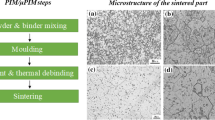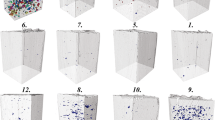Abstract
Micropowder injection molding (μ-PIM) is one of the most promising processes of mass production for the fabrication of small complex shaped ceramic or metallic parts with high sintered density. However, dimensional accuracy of finished parts is difficult to achieve because of extremely high shear rates during the injection molding process. This promotes the separation of powder and binder even in highly homogeneous feedstocks leading to a particle density variation in the green part causing anisotropic shrinkage during sintering. The main objective of this study is to investigate the effect of the powder particle distribution in injection molded green metallic microparts with respect to the molding parameters using synchrotron microtomography (S-μCT) and three-dimensional (3D) image evaluation. Image analysis has been performed using the MAVI software package. To get information about the allocation of the metal particles along the sample the 3D CT-scans have been segmented and statistically analyzed via spatially resolved size distributions. Furthermore, the spatial arrangement of the particles has been investigated using the so-called summary statistics from the area of point process statistics. The results show that variations in the size distribution of the metal powder particles can be detected and give consistent evidence for a monotonic increase in particle size with distance to the injection point. In order to give recommendations for the choice of parameters as well as tool construction, knowledge about the causes for separation effects is essential. This study shows that S-μCT is a well-adapted analytical tool to investigate the powder-particle distribution in μ-PIM.








Similar content being viewed by others
References
German RM (1990) Powder injection moulding. Metal Powder Industries Federation, Princeton
Heldele R, Rath S, Merz L, Butzbach R, Hagelstein M, Hausselt J (2006) Nucl Instrum & Meth Phys Res B 246:211
Gelin JC, Barriere T, Song J (2010) J Eng Mater Technol 132:011017
MAVI—Modular Algorithms for Volume Images (2010) Fraunhofer ITWM, Department of Image Processing, Kaiserslautern. http://www.mavi-3d.de. Accessed 25 Jan 2011
Rack A, Weitkamp T, Trabelsi SB, Modregger P, Cecilia A et al (2009) Nucl Instrum & Meth Phys Res B 267:1978
Heldele R (2008) Adv Powder Metall Part Mater IV(Part 11)
Weitkamp T, Tafforeau P, Boller E, Cloetens P, Valade JP et al (2010) AIP Conf Proc 1221:33
Banhart J (2008) Advanced tomographic methods in materials research and engineering. Oxford University Press, Oxford
Stock SR (2008) Microcomputed tomography: methodology and applications. CRC Press, London
Koch A, Raven C, Spanne P, Snigirev A (1998) J Opt Soc Am A 15:1940
Martin T, Koch A (2006) J Synchrotron Rad 13:180
Labiche JC, Mathon O, Pascarelli S et al (2007) Rev Sci Instrum 78:0901301
Mirone A, Wilcke R, Hammersley A, Ferrero C (2010). http://www.esrf.eu/UsersAndScience/Experiments/TBS/SciSoft/. Accessed 20 Jan 2011
Kak AC, Slaney M (1988) Principles of computerized tomographic imaging. IEEE Press, New York
Ohser J, Schladitz K (2009) 3D images of materials structures—processing and analysis. Wiley-VCH, Weinheim
Tek FB, Dempster AG, Kale I (2005) Comp Imag Vis 30:441
Illian J (2008) Statistical analysis and modelling of spatial point patterns. Wiley, Chichester
Acknowledgements
The authors would like to acknowledge Elodie Boller (ESRF) for her support at the beamline ID19 and the colleagues from KIT for doing the μ-PIM experiments. Financial support by the Deutsche Forschungsgemeinschaft (DFG, German Research Foundation) in the framework of the Collaborate Research Project SFB499 is greatly acknowledged.
Author information
Authors and Affiliations
Corresponding author
Rights and permissions
About this article
Cite this article
Weber, O., Rack, A., Redenbach, C. et al. Micropowder injection molding: investigation of powder-binder separation using synchrotron-based microtomography and 3D image analysis. J Mater Sci 46, 3568–3573 (2011). https://doi.org/10.1007/s10853-011-5270-9
Received:
Accepted:
Published:
Issue Date:
DOI: https://doi.org/10.1007/s10853-011-5270-9




